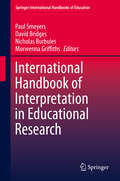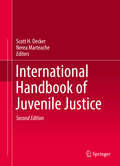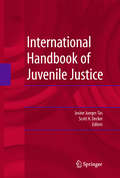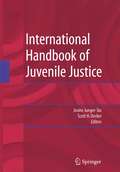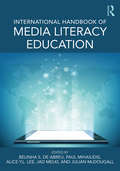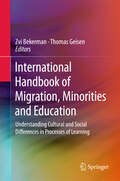- Table View
- List View
International Handbook of Autism and Pervasive Developmental Disorders (Autism and Child Psychopathology Series)
by Johnny L. Matson and Peter SturmeySince the early 1940s, when first identified as childhood psychosis and autistic psychopathy, autism spectrum disorder (ASD) has continued to burgeon into a major focus of inquiry and interest among researchers, practitioners, and the public alike. With each passing decade, the number of scholarly articles addressing ASD and related disabilities continues to soar. Today, thousands of papers on autism are published annually across various disciplines and journals, making it challenging – if not impossible – to keep pace with, let alone synthesize, all the latest developments.Based on a solid historical foundation of autism theory and research, the International Handbook of Autism and Pervasive Developmental Disorders integrates the broad scholarly base of literature with a trenchant analysis of the state of the field in nosology, etiology, assessment, and treatment. Its expert contributors examine recent findings and controversies (e.g., how prevalent autism actually is), along with longstanding topics of interest as well as emerging issues.Coverage includes:A survey of diagnostic criteria and assessment strategies.Genetic, behavioral, biopsychosocial, and cognitive models.Psychiatric disorders in persons with ASD.Theory of mind and facial recognition.Diagnostic instruments for assessing core features and challenging behaviors.Evidence-based psychosocial, pharmacological, and integrative treatments.Interventions specifically for adults with ASD.Training issues for professionals and parents.A review of findings of successful and promising therapies, coupled with guidance on how to distinguish between dubious and effective treatments.The International Handbook of Autism and Pervasive Developmental Disorders is an indispensable resource for researchers, professors, graduate students, and allied practitioners in clinical child and school psychology, child and adolescent psychiatry, education, social work, rehabilitation, pediatric medicine, and developmental psychology.
The International Handbook of Black Community Mental Health
by Richard Majors Karen Carberry Theodore RansawThis is the first international handbook on Black community mental health, focussing on key issues including stereotypes in Mental health, misdiagnoses, and inequalities/discrimination around access, services and provisions. Making use of a cultural competence framework throughout, the book covers many of the classic mental health/developmental areas such as schizophrenia, mental health disorders, ASD and ADHD, but it also looks at more controversial areas in mental health, like inequalities, racism and discrimination both in practice and in graduate school training and the supervisory experiences of black students in universities. Unique among traditional academic texts addressing mental health, the book presents rich personal accounts from Black therapists and students. Many Black students who are training to become therapists or academics in mental health report negative experiences with white university staff in terms of a lack of support, encouragement, resulting in poor graduation outcomes.While institutional racism is a major issue both in society and universities, the editors of this Handbook take personal-level racism, microaggression and everyday racism as better models for understanding and analysing both these students; racialised interaction/communication experiences with white staff at university, as well as the racialised communications and inequalities in misdiagnoses, access to services and provisions in healthcare settings with white managers.
The International Handbook of Black Community Mental Health
by Richard Majors Karen Carberry Theodore S. RansawThis is the first international handbook on Black community mental health, focussing on key issues including stereotypes in Mental health, misdiagnoses, and inequalities/discrimination around access, services and provisions. Making use of a cultural competence framework throughout, the book covers many of the classic mental health/developmental areas such as schizophrenia, mental health disorders, ASD and ADHD, but it also looks at more controversial areas in mental health, like inequalities, racism and discrimination both in practice and in graduate school training and the supervisory experiences of black students in universities. Unique among traditional academic texts addressing mental health, the book presents rich personal accounts from Black therapists and students. Many Black students who are training to become therapists or academics in mental health report negative experiences with white university staff in terms of a lack of support, encouragement, resulting in poor graduation outcomes.While institutional racism is a major issue both in society and universities, the editors of this Handbook take personal-level racism, microaggression and everyday racism as better models for understanding and analysing both these students; racialised interaction/communication experiences with white staff at university, as well as the racialised communications and inequalities in misdiagnoses, access to services and provisions in healthcare settings with white managers.
International Handbook of Cognitive and Behavioural Treatments for Psychological Disorders
by V. E. CaballoThis handbook shows the wide perspective cognitive-behavioural treatment can offer to health professionals, the vast majority of whom now recognize that cognitive behavioural procedures are very useful in treating many 'mental' disorders, even if certain disciplines continue to favour other kinds of treatment. This book offers a wide range of structured programmes for the treatment of various psychological/psychiatric disorders as classified by the DSM-IV. The layout will be familiar to the majority of health professionals in the description of mental disorders and their later treatment. It is divided into seven sections, covering anxiety disorders, sexual disorders, dissociative, somatoform, impulse control disorders, emotional disorders and psychotic and organic disorders. Throughout the twenty-three chapters, this book offers the health professional a structured guide with which to start tackling a whole series of 'mental' disorders and offers pointers as to where to find more detailed information. The programmes outlined should, it is hoped, prove more effective than previous approaches with lower economic costs and time investment for the patient and therapist.
International Handbook of Evidence-Based Coaching: Theory, Research and Practice
by Jonathan Passmore Heidi Möller Wolfgang Scholl Felix Müller Siegfried GreifThis handbook comprehensively covers the fundamental key concepts in coaching research and evidence-based practice and shows how coaching can be applied to multiple contexts. It provides coaching scholars, researchers and practitioners with detailed review of the key concepts, research and new insights into coaching research and practice. This key reference work includes over 70 contributions from more than 110 leading researchers and practitioners in the field across countries, and deftly combines theory with case studies and applications from psychology, sociology, business administration, organizational studies, education, and communication studies. This handbook, edited by the top scholars in the field, is meant for an academic as well as a professional readership, and is an invaluable resource for coaches, clients, coaching institutes and associations, and students of coaching.
The International Handbook of Gender and Poverty: Concepts, Research, Policy (PDF) (Elgar Original Reference Ser.)
by Sylvia ChantIn the interests of contextualising (and nuancing) the multiple interrelations between gender and poverty, Sylvia Chant has gathered writings on diverse aspects of the subject from a range of disciplinary and professional perspectives, achieving extensive thematic as well as geographical coverage. This benchmark volume presents women's and men's experiences of gendered poverty with respect to a vast spectrum of intersecting issues including local to global economic transformations, family, age, `race', migration, assets, paid and unpaid work, health, sexuality, human rights, and conflict and violence. The Handbook also provides up-to-the-minute reflections on how to theorise, measure and represent the connections between gender and poverty, and to contemplate how gendered poverty is affected - and potentially redressed - by policy and grassroots interventions. An unprecedented and ambitious blend of conceptual, methodological, empirical and practical offerings from a host of established as well as upcoming scholars and professionals from across the globe lends the volume a distinctive and critical edge. Notwithstanding the broad scope of The International Handbook of Gender and Poverty, one theme in common to most of its 100-plus chapters is the need to `en-gender' analysis and initiatives to combat poverty and inequality at local, national and international levels. As such, the volume will inspire its readers not only to reflect deeply on poverty and gender injustice, but also to consider what to do about it. This book will be essential reading for all with academic, professional or personal interests in gender, poverty, inequality, development, and social, political and economic change in the contemporary world.
International Handbook of Historical Archaeology
by David Gaimster Teresita MajewskiIn studying the past, archaeologists have focused on the material remains of our ancestors. Prehistorians generally have only artifacts to study and rely on the diverse material record for their understanding of past societies and their behavior. Those involved in studying historically documented cultures not only have extensive material remains but also contemporary texts, images, and a range of investigative technologies to enable them to build a broader and more reflexive picture of how past societies, communities, and individuals operated and behaved. Increasingly, historical archaeology refers not to a particular period, place, or a method, but rather an approach that interrogates the tensions between artifacts and texts irrespective of context. In short, historical archaeology provides direct evidence for how humans have shaped the world we live in today.Historical archaeology is a branch of global archaeology that has grown in the last 40 years from its North American base into an increasingly global community of archaeologists each studying their area of the world in a historical context. Where historical archaeology started as part of the study of the post-Columbian societies of the United States and Canada, it has now expanded to interface with the post-medieval archaeologies of Europe and the diverse post-imperial experiences of Africa, Latin America, and Australasia.The 36 essays in the International Handbook of Historical Archaeology have been specially commissioned from the leading researchers in their fields, creating a wide-ranging digest of the increasingly global field of historical archaeology. The volume is divided into two sections, the first reviewing the key themes, issues, and approaches of historical archaeology today, and the second containing a series of case studies charting the development and current state of historical archaeological practice around the world. This key reference work captures the energy and diversity of this global discipline today.
International Handbook of Internet Research
by Jeremy Hunsinger Lisbeth Klastrup Matthew AllenInternet research spans many disciplines. From the computer or information s- ences, through engineering, and to social sciences, humanities and the arts, almost all of our disciplines have made contributions to internet research, whether in the effort to understand the effect of the internet on their area of study, or to investigate the social and political changes related to the internet, or to design and develop so- ware and hardware for the network. The possibility and extent of contributions of internet research vary across disciplines, as do the purposes, methods, and outcomes. Even the epistemological underpinnings differ widely. The internet, then, does not have a discipline of study for itself: It is a ?eld for research (Baym, 2005), an open environment that simultaneously supports many approaches and techniques not otherwise commensurable with each other. There are, of course, some inhibitions that limit explorations in this ?eld: research ethics, disciplinary conventions, local and national norms, customs, laws, borders, and so on. Yet these limits on the int- net as a ?eld for research have not prevented the rapid expansion and exploration of the internet. After nearly two decades of research and scholarship, the limits are a positive contribution, providing bases for discussion and interrogation of the contexts of our research, making internet research better for all. These ‘limits,’ challenges that constrain the theoretically limitless space for internet research, create boundaries that give de?nition to the ?eld and provide us with a particular topography that enables research and investigation.
International Handbook of Interpretation in Educational Research (Springer International Handbooks of Education)
by Paul Smeyers David Bridges Nicholas C. Burbules Morwenna GriffithsThis handbook focuses on the often neglected dimension of interpretation in educational research. It argues that all educational research is in some sense ‘interpretive’, and that understanding this issue belies some usual dualisms of thought and practice, such as the sharp dichotomy between ‘qualitative’ and ‘quantitative’ research. Interpretation extends from the very framing of the research task, through the sources which constitute the data, the process of their recording, representation and analysis, to the way in which the research is finally or provisionally presented. The thesis of the handbook is that interpretation cuts across the fields (both philosophically, organizationally and methodologically).By covering a comprehensive range of research approaches and methodologies, the handbook gives (early career) researchers what they need to know in order to decide what particular methods can offer for various educational research contexts/fields. An extensive overview includes concrete examples of different kinds of research (not limited for example to ‘teaching’ and ‘learning’ examples as present in the Anglo-Saxon tradition, but including as well what in the German Continental tradition is labelled ‘pädagogisch’, examples from child rearing and other contexts of non-formal education) with full description and explanation of why these were chosen in particular circumstances and reflection on the wisdom or otherwise of the choice – combined in each case with consideration of the role of interpretation in the process. The handbook includes examples of a large number of methods traditionally classified as qualitative, interpretive and quantitative used across the area of the study of education. Examples are drawn from across the globe, thus exemplifying the different ‘opportunities and constraints’ that educational research has to confront in different societies.
International Handbook of Juvenile Justice (Proceedings In Life Sciences Ser.)
by Scott H Decker Nerea MarteacheThis comprehensive reference work presents an in-depth analysis of juvenile justice systems across the world. The second edition of this Handbook has been updated with 13 new chapters, now covering a total of 34 countries, across North and South America, Europe, Asia, Africa, and the Middle East from an international and comparative perspective. The International Handbook of Juvenile Justice is the result of research conducted by a group of outstanding scholars working in the field of juvenile justice. It reflects a collective concern about trends in juvenile justice over the past two decades, trends that have begun to blur the difference between criminal and juvenile justice. Also new to the second edition, each chapter is formatted to increase the comparative aspect of the book, highlighting: · The legal status of juveniles· Age of majority· The country’s stance toward the UN Committee on the Rights of the Child· Trends in juvenile crime over the period 2004-2014· Causes of juvenile crime· Policing and juveniles· Courts and juveniles· Custodial rules for juveniles (detention, prison, mixing juveniles with adults)· Alternative sanctions for juveniles: home confinement, restorative justice, restitution, etc.· Differences in treatment of boys and girls This seminal work highlights similarities and differences between the various systems, and will be an important reference for researchers in criminology and criminal justice, particularly interested in juvenile delinquency and youth crime, as well as related disciplines like sociology, social work, and public policy.
International Handbook of Juvenile Justice (Proceedings In Life Sciences Ser.)
by Josine Junger-Tas Scott H. DeckerThis comprehensive reference work presents inside information on the Juvenile Justice-systems in 19 different countries, both in old and new EU-member states and in the United States and Canada. The book is the result of research conducted by a group of outstanding researchers, who are concerned about trends in Juvenile Justice in the last two decades, which blur the border between criminal and juvenile justice.
International Handbook of Juvenile Justice
by Josine Junger-Tas Scott H. DeckerThis comprehensive reference work presents inside information on the Juvenile Justice-systems in 19 different countries, both in old and new EU-member states and in the United States and Canada. The book is the result of research conducted by a group of outstanding researchers, who are concerned about trends in Juvenile Justice in the last two decades, which blur the border between criminal and juvenile justice.
International Handbook of Love: Transcultural and Transdisciplinary Perspectives
by Elisabeth Vanderheiden Claude-Hélène MayerTh is handbook includes state-of-the-art research on love in classical, modern and postmodern perspectives. It expands on previous literature and explores topics around love from new cultural, intercultural and transcultural approaches and across disciplines. It provides insights into various love concepts, like romantic love, agape, and eros in their cultural embeddedness, and their changes and developments in specific cultural contexts. It also includes discussions on postmodern aspects with regard to love and love relationships, such as digitalisation, globalisation and the fourth industrial revolution. Th e handbook covers a vast range of topics in relation to love: aging, health, special needs, sexual preferences, spiritual practice, subcultures, family and other relationships, and so on. Th e chapters look at love not only in terms of the universal concept and in private, intimate relationships, but apply a broad concept of love which can also, for example, be referred to in postmodern workplaces. Th is volume is of interest to a wide readership, including researchers, practitioners and students of the social sciences, humanities and behavioural sciences.In the 1970s through the 90s, I was told that globalization was homogenizing cultures into a worldwide monoculture. Th is volume, as risky and profound as the many adventures of love across our multiplying cultures are, proves otherwise. Th e authors’ revolutionary and courageous work will challenge our sensibilities and expand the boundaries of what we understand what love is. But that’s what love does: It communicates what is; offers what can be; and pleads for what must be. I know you’ll enjoy this wonderful book as much as I do!Jeffrey Ady, Associate Professor (retired), Public Administration Program, University of Hawaii at Manoa, Founding Fellow, International Academy for Intercultural ResearchThe International Handbook of Love is far more than a traditional compendium. It is a breath-taking attempt to synthesize our anthropological and sociological knowledge on love. It illuminates topics as diverse as Chinese love, one-night stands, teen romance or love of leaders and many more. Th is is a definitive reference in the field of love studies.Eva Illouz, author of Th e End of Love: A sociology of Negative relationships. Oxford University Press.
International Handbook of Media Literacy Education
by Belinha S. De Abreu Paul Mihailidis Alice Y.L. Lee Jad Melki Julian McDougallAt the forefront in its field, this Handbook examines the theoretical, conceptual, pedagogical and methodological development of media literacy education and research around the world. Building on traditional media literacy frameworks in critical analysis, evaluation, and assessment, it incorporates new literacies emerging around connective technologies, mobile platforms, and social networks. A global perspective rather than a Western-centric point of view is explicitly highlighted, with contributors from all continents, to show the empirical research being done at the intersection of media, education, and engagement in daily life. Structured around five themes—Educational Interventions; Safeguarding/Data and Online Privacy; Engagement in Civic Life; Media, Creativity and Production; Digital Media Literacy—the volume as a whole emphasizes the competencies needed to engage in meaningful participation in digital culture.
International Handbook Of Media Literacy Education
by Belinha S. De Abreu Paul Mihailidis Alice Y. L. Lee Jad Melkin Julian McDougallAt the forefront in its field, this Handbook examines the theoretical, conceptual, pedagogical and methodological development of media literacy education and research around the world. Building on traditional media literacy frameworks in critical analysis, evaluation, and assessment, it incorporates new literacies emerging around connective technologies, mobile platforms, and social networks. A global perspective rather than a Western-centric point of view is explicitly highlighted, with contributors from all continents, to show the empirical research being done at the intersection of media, education, and engagement in daily life. Structured around five themes--Educational Interventions; Safeguarding/Data and Online Privacy; Engagement in Civic Life; Media, Creativity and Production; Digital Media Literacy--the volume as a whole emphasizes the competencies needed to engage in meaningful participation in digital culture.
International Handbook of Media Literacy Education
At the forefront in its field, this Handbook examines the theoretical, conceptual, pedagogical and methodological development of media literacy education and research around the world. Building on traditional media literacy frameworks in critical analysis, evaluation, and assessment, it incorporates new literacies emerging around connective technologies, mobile platforms, and social networks. A global perspective rather than a Western-centric point of view is explicitly highlighted, with contributors from all continents, to show the empirical research being done at the intersection of media, education, and engagement in daily life. Structured around five themes—Educational Interventions; Safeguarding/Data and Online Privacy; Engagement in Civic Life; Media, Creativity and Production; Digital Media Literacy—the volume as a whole emphasizes the competencies needed to engage in meaningful participation in digital culture.
International Handbook Of Media Literacy Education (PDF)
by Belinha S. De Abreu Paul Mihailidis Alice Y. L. Lee Jad Melkin Julian McDougallAt the forefront in its field, this Handbook examines the theoretical, conceptual, pedagogical and methodological development of media literacy education and research around the world. Building on traditional media literacy frameworks in critical analysis, evaluation, and assessment, it incorporates new literacies emerging around connective technologies, mobile platforms, and social networks. A global perspective rather than a Western-centric point of view is explicitly highlighted, with contributors from all continents, to show the empirical research being done at the intersection of media, education, and engagement in daily life. Structured around five themes--Educational Interventions; Safeguarding/Data and Online Privacy; Engagement in Civic Life; Media, Creativity and Production; Digital Media Literacy--the volume as a whole emphasizes the competencies needed to engage in meaningful participation in digital culture.
International Handbook of Migration and Population Distribution (International Handbooks of Population #6)
by Michael J. WhiteThis Handbook offers a comprehensive collection of essays that cover essential features of geographical mobility, from internal migration, to international migration, to urbanization, to the adaptation of migrants in their destinations. Part I of the collection introduces the range of theoretical perspectives offered by several social science disciplines, while also examining the crucial relationship between internal and international migration. Part II takes up methods, ranging from how migration data are best collected to contemporary techniques for analyzing such data. Part III of the handbook contains summaries of present trends across all world regions. Part IV rounds out the volume with several contributions assessing pressing issues in contemporary policy areas. The volume’s editor Michael J. White has spent a career studying the pattern and process of internal and international migration, urbanization and population distribution in a wide variety of settings, from developing societies to advanced economies. In this Handbook he brings together contributors from all parts of the world, gathering in this one volume both geographical and substantive expertise of the first rank. The Handbook will be a key reference source for established scholars, as well as an invaluable high-level introduction to the most relevant topics in the field for emerging scholars.
International Handbook of Migration, Minorities and Education: Understanding Cultural and Social Differences in Processes of Learning
by Zvi Bekerman and Thomas GeisenMigrants and minorities are always at risk of being caught in essentialized cultural definitions and being denied the right to express their cultural preferences because they are perceived as threats to social cohesion. Migrants and minorities respond to these difficulties in multiple ways — as active agents in the pedagogical, political, social, and scientific processes that position them in this or that cultural sphere. On the one hand, they reject ascribed cultural attributes while striving towards integration in a variety of social spheres, e.g. school and workplace, in order to achieve social mobility. On the other hand, they articulate demands for cultural self-determination. This discursive duality is met with suspicion by the majority culture. For societies with high levels of migration or with substantial minority cultures, questions related to the meaning of cultural heterogeneity and the social and cultural limits of learning and communication (e.g. migration education or critical multiculturalism) are very important. It is precisely here where the chances for new beginnings and new trials become of great importance for educational theorizing, which urgently needs to find answers to current questions about individual freedom, community/cultural affiliations, and social and democratic cohesion. Answers to these questions must account for both ‘political’ and ‘learning’ perspectives at the macro, mezzo, and micro contextual levels. The contributions of this edited volume enhance the knowledge in the field of migrant/minority education, with a special emphasis on the meaning of culture and social learning for educational processes.
International Handbook of Population Aging (International Handbooks of Population #1)
by Peter UhlenbergThe International Handbook of Population Aging examines research on a wide array of the profound implications of population aging. It demonstrates how the world is changing through population aging, and how demography is changing in response to it.
International Handbook of Population and Environment (International Handbooks of Population #10)
by Jacques Véron Lori M. Hunter Clark GrayThis handbook presents a timely and comprehensive overview of theory, data, methods and research findings that connect human population dynamics and environmental context. It presents regional summaries of empirical findings on migration and environmental connections and summarizes environmental impacts of migration – such as urbanization and deforestation. It also offers background on the health implications of environmental conditions such as climate change, natural disasters, scarcity of natural resources, as well as on resource scarcity and fertility, gender considerations in population and environment, and the connections between population size, growth, composition and carbon emissions. This handbook helps readers to better understand the complexities within population-environment connections, in addition to some of the opportunities and challenges within environmental demography. As such this collection is an invaluable resource for students, researchers, and policy analysts in the areas of demography, migration, fertility, health and mortality, as well as environmental, global and development studies.
International Handbook of Population Policies (International Handbooks of Population #11)
by John F. May Jack A. GoldstoneThis Handbook offers an array of internationally recognized experts’ essays that provide a current and comprehensive examination of all dimensions of international population policies. The book examines the theoretical foundations, the historical and empirical evidence for policy formation, the policy levers and modelling, as well as the new policy challenges. The section Theoretical Foundations reviews population issues today, population theories, the population policies’ framework as well as the linkages between population, development, health, food systems, and the environment. The next section Empirical Evidence discusses international approaches to design and implement population policies on a regional level. The section Policy Levers and Modelling reviews the tools and the policy levers that are available to design, implement, monitor, and measure the impact of population policies. Finally, the section New Policy Challenges examines the recurrent and emerging issues in population policies. This section also discusses prospects for demographic sustainability as well as future considerations for population policies. As such this Handbook provides an important and structured examination of contemporary population policies, their evolution, and their prospects.
International Handbook of Psychological Well-Being in Children and Adolescents: Bridging the Gaps Between Theory, Research, and Practice
by Bonnie Kaul Nastasi Amanda P. BorjaThis handbook addresses universal developmental and cultural factors contributing to child and adolescent mental health and well-being across the globe. It examines sociocultural contexts of development and identifies children's and adolescents' perspectives as critical to understanding and promoting their psychological well-being. It details the Promoting Psychological Well-Being Globally project’s methodology for data collection and analysis, provides cross-cultural analyses of its findings, and offers a practical model for clinicians and other professionals seeking to apply this knowledge to real-life settings.Featured topics include: Sexual health, gender roles, and psychological well-being in India.Psychological well-being as a new educational boundary in Italy.Mapping psychological well-being in Romania.Youth perspectives on contributing factors to psychological well-being in Sri Lanka.Culturally specific resilience and vulnerability in Tanzania.Longing for a balanced life – the voices of Chinese-American/immigrant youth in the United States.The International Handbook of Psychological Well-Being in Children and Adolescents: Bridging the Gaps Between Theory, Research, and Practice is an invaluable resources for researchers, clinicians, scientist-practitioners, and graduate students in child and school psychology, social work, public health, positive psychology, educational policy and politics, and maternal and child health.
International Handbook of Rural Demography (International Handbooks of Population #3)
by László J. J. Kulcsár and Katherine J. J. CurtisThis is the third in an essential series of Springer handbooks that explore key aspects of the nexus between demography and social science. With an inclusive international perspective, and founded on the principles of social demography, this handbook shows how the rural population, which recently dropped below 50 per cent of the world total, remains a vital segment of society living in proximity to much-needed developmental and amenity resources. The rich diversity of rural areas shapes the capacity of resident communities to address far-reaching social, environmental and economic challenges. Some will survive, become sustainable and even thrive, while others will suffer rapid depopulation. This handbook demonstrates how these future development trajectories will vary according to local characteristics including, but not limited to, population composition. The growing complexity of rural society is in part a product of significant international variations in population trends, making this comparative and comprehensive study of rural demography all the more relevant. Collating the latest research on international rural demography, the handbook will be an invaluable aid to policy makers as they try to understand how demographic dynamics depend on the economic, social and environmental characteristics of rural areas. It will also aid researchers assessing the unique factors at play in the rural context and endeavoring to produce meaningful results that will advance policy and scholarship. Finally, the handbook is an ideal text for graduate students in a spread of disciplines from sociology to international development.
International Handbook of the Demography of Obesity (International Handbooks of Population #12)
by Ginny Garcia-Alexander Dudley L. PostonThis handbook provides a demographic examination of global obesity trends by bringing together the range of research conducted in this field by demographers, sociologists, epidemiologists, and other quantitatively and demographically oriented social scientists. It utilizes a multidisciplinary demographic approach to provide insights into the global prevalence and mechanisms of obesity, as well as the population level impacts of rising obesity. Major sections include: global obesity trends and prevalence; obesity and demographic structures, processes, and characteristics; emerging areas of study; and obesity in LGBAT populations. This handbook provides readers with a broad understanding of population-based research on obesity and serves as a resource for scholars, students, policymakers, and researchers.







